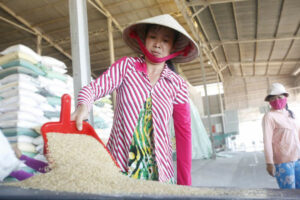RICE IMPORTERS are expected to continue relying on Vietnam for their supply even after India eased it export controls on white rice, analysts said.
On Saturday, the India’s Directorate of Foreign Trade announced the lifting of the export ban on non-basmati white rice, citing high inventory levels. The Indian government imposed a minimum export price of $490 per metric ton (MT).
Former Agriculture Undersecretary Fermin D. Adriano said Vietnamese traders are expected to match India’s low export price, pushing prices lower overall.
Vietnam is the Philippines’ top supplier of rice. Both governments signed a supply agreement in January giving the Philippines a quota of 1.5 million MT to 2 million MT of rice annually for five years.
“If that happens, our traders will import from their usual Vietnamese ‘suki’ (trusted sellers) instead of buying from India as they are not familiar with the exporters there,” Mr. Adriano said via Viber.
India, the world’s largest exporter of white rice, suspended exports of non-basmati white rice last year amid concerns over domestic supply, putting upward pressure on international prices.
“We hope that world price of rice will go down a bit,” Agriculture Secretary Francisco P. Tiu Laurel, Jr. said via text message.
Mr. Laurel has said that the ban on Indian rice exports pushed world rice prices higher, elevating the cost of imports which the government is counting on to keep rice affordable.
To lower the price of rice, President Ferdinand R. Marcos, Jr. signed Executive Order No. (EO) 62, which reduced tariffs on imported rice to 15% from 35% until 2028.
The Department of Agriculture (DA) said that EO 62 could bring down rice prices by P6 to P7 per kilogram.
“The lifting of the import ban could increase overall supply in the global rice market and lead to a softening of international rice prices,” Federation of Free Farmers National Director Raul Q. Montemayor said via Viber.
He added that the minimum export price is about 10% less than the $500 per MT export price charged by Vietnam and Thailand.
“It is only a minimum, so actual selling prices could be higher,” Mr. Montemayor said.
He added that importers have not patronized Indian rice despite the low price, citing quality and reliability concerns. “In the past, more rice from Pakistan was imported than from India,” he added.
“This is a big relief globally and particularly the Philippines. With EO 62 in place, the importers will now have a choice as where to source rice, much more affordable rice,” former Agriculture Secretary William D. Dar said in a text message.
The Philippines typically imports about 20% of its rice requirement.
“The Indian rice will be an attraction to importers because it will be cheaper as long as the quality is the same as that those coming from Vietnam and Thailand,” he added.
Rice imports totaled 3.09 million MT as of Sept. 19, according to the Bureau of Plant Industry. Rice imports from Pakistan amounted to 157,044 MT.
The US Department of Agriculture said that Philippine rice imports are expected to hit 4.6 million MT this year. — Adrian H. Halili
